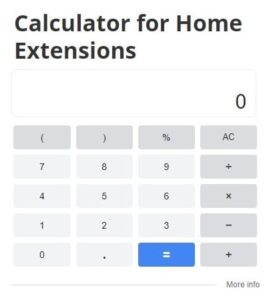
The landscape of home renovation tax benefits is changing dramatically in 2024. New tax rules for home renovations are set to reshape how homeowners can claim deductions and credits for their improvement projects.
At Home Owners Association, we’ve analyzed these changes to help our members navigate the updated tax landscape. This guide will break down the key updates, highlight potential benefits, and warn against common pitfalls in claiming renovation-related tax advantages.
What’s New for Home Renovation Tax Benefits in 2024?
Enhanced Energy Efficiency Credits
The tax landscape for home renovations has undergone significant changes in 2024, offering homeowners new opportunities to maximize their tax benefits. These updates primarily focus on energy-efficient improvements and introduce stricter eligibility criteria for claiming renovation expenses.
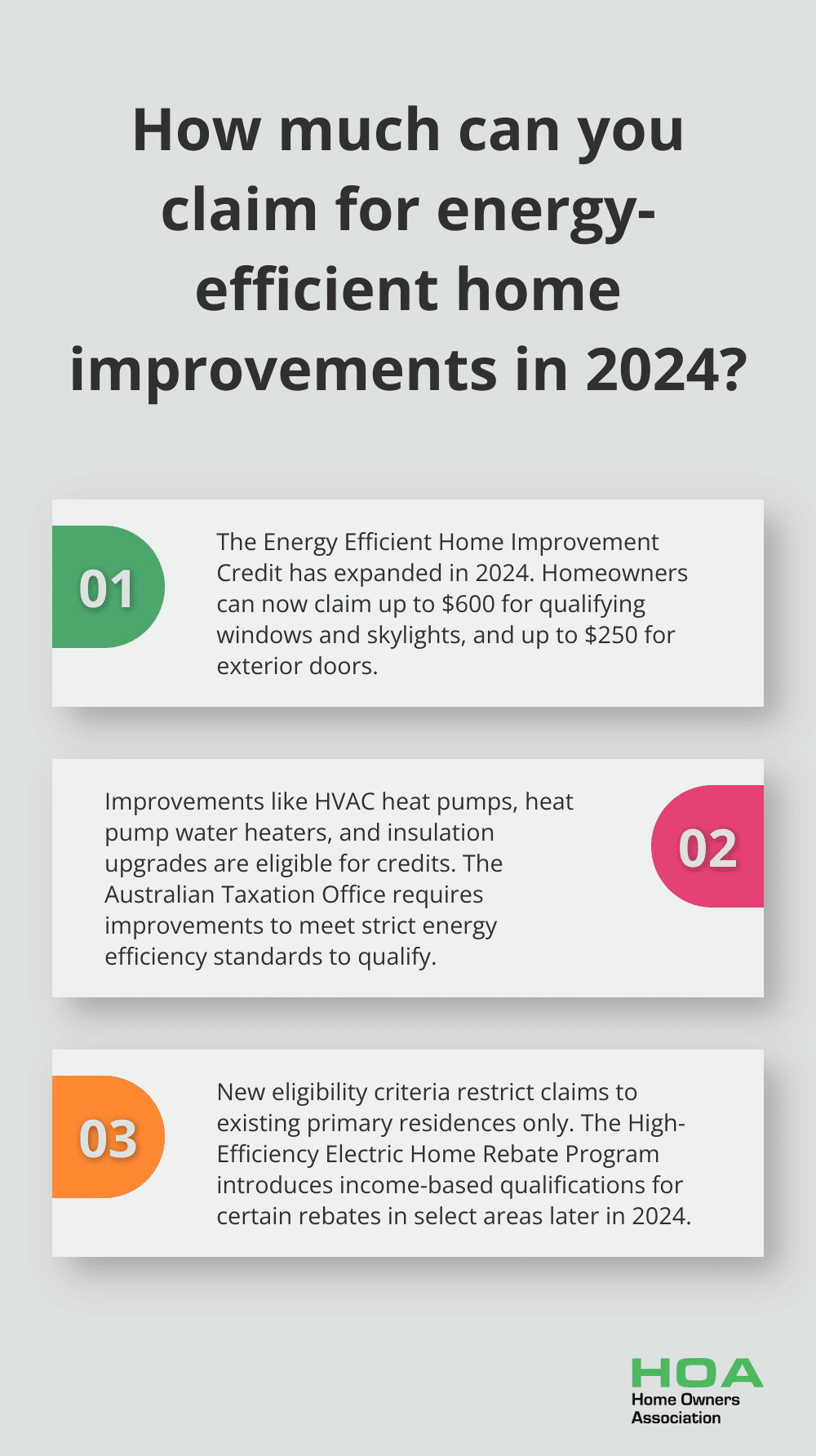
The expansion of the Energy Efficient Home Improvement Credit stands out as one of the most notable changes. Homeowners can now claim up to $600 for qualifying windows and skylights, and up to $250 for exterior doors. This represents a substantial increase from previous years and applies to improvements such as HVAC heat pumps, heat pump water heaters, and insulation upgrades.
The Australian Taxation Office (ATO) has specified that improvements must meet stringent energy efficiency standards to qualify for these credits. Homeowners should verify that their chosen upgrades meet these criteria before installation.
New Eligibility Criteria
The ATO has tightened the eligibility criteria for claiming renovation expenses in 2024. Improvements must now be made to an existing home that serves as the taxpayer’s primary residence. New constructions and rental properties do not qualify for these specific credits.
The High-Efficiency Electric Home Rebate Program (HEEHRA) introduces income-based qualifications for certain rebates. This program offers tax credits for heat pumps, heat pump water heaters, weatherization, electric panel upgrades, solar and battery storage. Set to roll out in select areas later in 2024, HEEHRA provides substantial benefits for energy-efficient electric systems.
Stricter Documentation Requirements
Documentation requirements for claiming renovation tax benefits have become more rigorous. Homeowners must now maintain detailed records of all improvement projects, including receipts, contracts, and before-and-after photographs. The ATO emphasizes the importance of keeping a separate tax file for renovation expenses throughout the year to simplify the claiming process.
For energy-efficient upgrades, a home energy audit is now required for many of the new tax credits. Qualified professionals (certified by programs recognized by the Department of Energy) must conduct these audits. Starting in 2024, auditors must provide a written report identifying cost-effective improvements to qualify for the $150 tax credit for home energy audits.
These changes in tax rules for home renovations offer significant opportunities for homeowners to reduce their tax burden while improving their properties. However, the complexity of these new regulations underscores the importance of careful planning and potentially seeking professional advice.
As we explore the various types of home improvements and their tax implications in the next section, you’ll gain a deeper understanding of how to maximize your benefits under these new rules.
How to Maximize Tax Benefits for Home Improvements
Energy-Efficient Upgrades: A Tax-Saving Powerhouse
The 2024 tax changes offer homeowners significant opportunities to maximize their benefits across various types of home improvements. Energy-efficient upgrades continue to be the most tax-advantageous home improvements in 2024. The Energy Efficient Home Improvement Credit now allows homeowners to claim up to 30% of the costs for qualified energy-saving upgrades, with a maximum annual credit of $3,200 for improvements made after January 1, 2023.
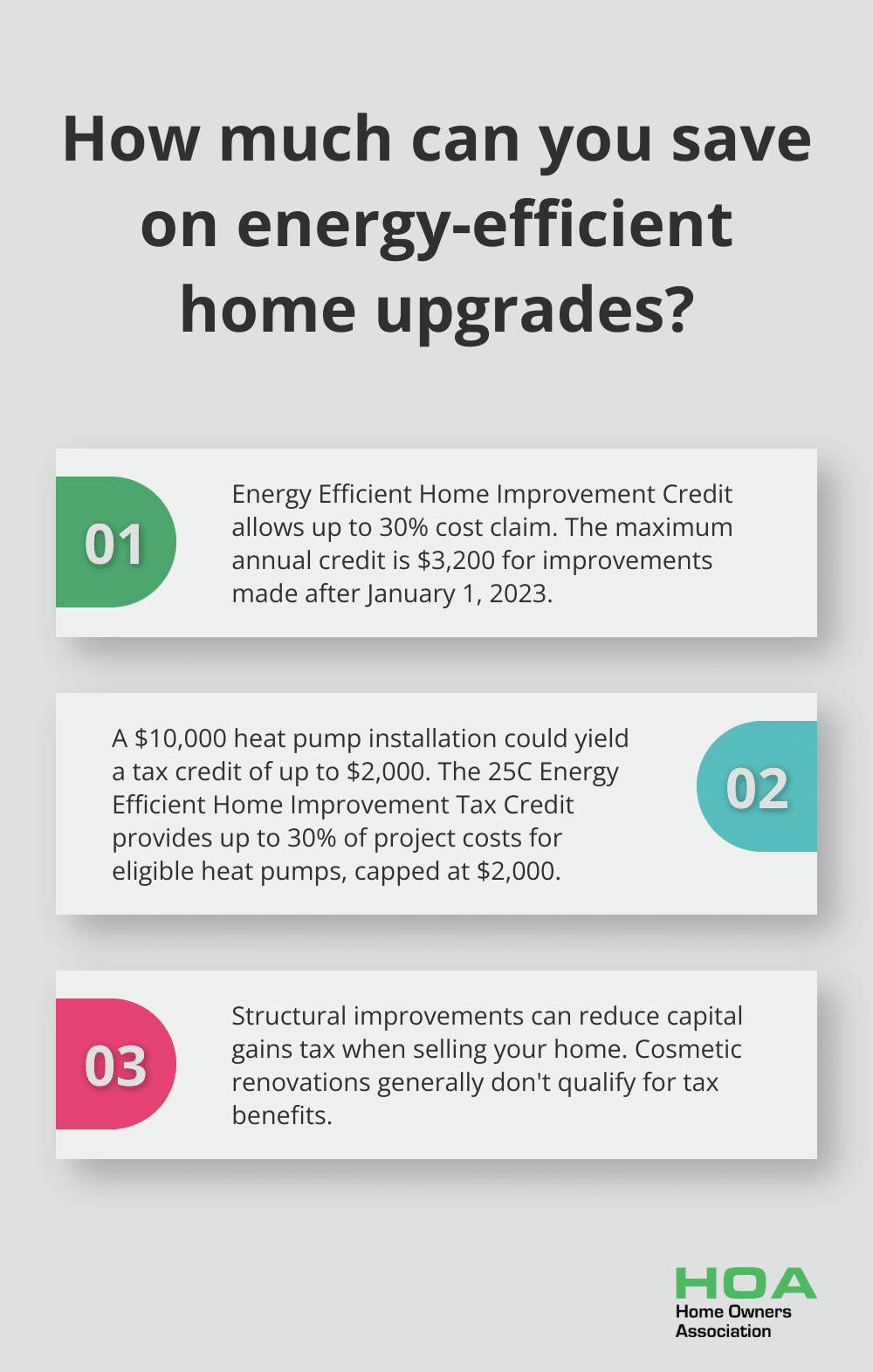
To maximize your benefits, focus on high-impact improvements such as installing heat pumps, upgrading to energy-efficient windows, or adding insulation. A $10,000 heat pump installation could potentially yield a tax credit of up to $2,000, as the 25C Energy Efficient Home Improvement Tax Credit provides a credit for eligible heat pumps up to 30% of project costs, capped at $2,000. These credits are available annually, so planning your upgrades over multiple years can maximize your total savings.
Structural vs. Cosmetic: Where to Focus for Tax Benefits
It’s important to understand the tax implications of different types of renovations. Structural improvements that increase your home’s value or extend its useful life can potentially reduce your capital gains tax when you sell your home. These might include adding a new room, upgrading your roof, or installing a new HVAC system.
Cosmetic renovations like painting or updating fixtures generally don’t qualify for tax benefits. However, they can still add value to your home and may be worth considering as part of a comprehensive renovation strategy.
Home Office Deductions: A New Landscape
With the rise of remote work, home office renovations have taken on new significance. While the tax rules for home offices have become more stringent, there are still opportunities for deductions. To qualify, you must use a portion of your home exclusively and regularly for your business.
If you meet these criteria, you can deduct a percentage of your home expenses (including mortgage interest, property taxes, and utilities), based on the square footage of your office space. Additionally, any direct expenses for maintaining or improving your home office area may be fully deductible.
For example, if your home office occupies 10% of your home’s total square footage, you could deduct 10% of your eligible home expenses. A $5,000 renovation to your home office space could potentially be fully deductible, saving you significant money on your taxes.
Maximizing Benefits Through Strategic Planning
To make the most of these new tax rules while improving your home, consider the following strategies:
- Prioritize energy-efficient upgrades to capitalize on the expanded tax credits.
- Plan major structural improvements over multiple years to maximize annual tax benefits.
- Keep detailed records of all home improvement expenses, including receipts and contracts.
- Consult with a tax professional to ensure you’re taking advantage of all available deductions and credits.
The complexity of these new regulations underscores the importance of careful planning and potentially seeking professional advice. As we explore common mistakes to avoid when claiming renovation tax benefits in the next section, you’ll gain valuable insights to help you navigate these new rules successfully.
Avoiding Tax Pitfalls in Home Renovations
Distinguishing Personal from Business Expenses
Many homeowners misclassify personal expenses as business-related, especially those with home offices. The ATO enforces strict guidelines on business expense qualifications. For example, a room renovation serving as both a home office and guest bedroom cannot be fully claimed as a business expense.
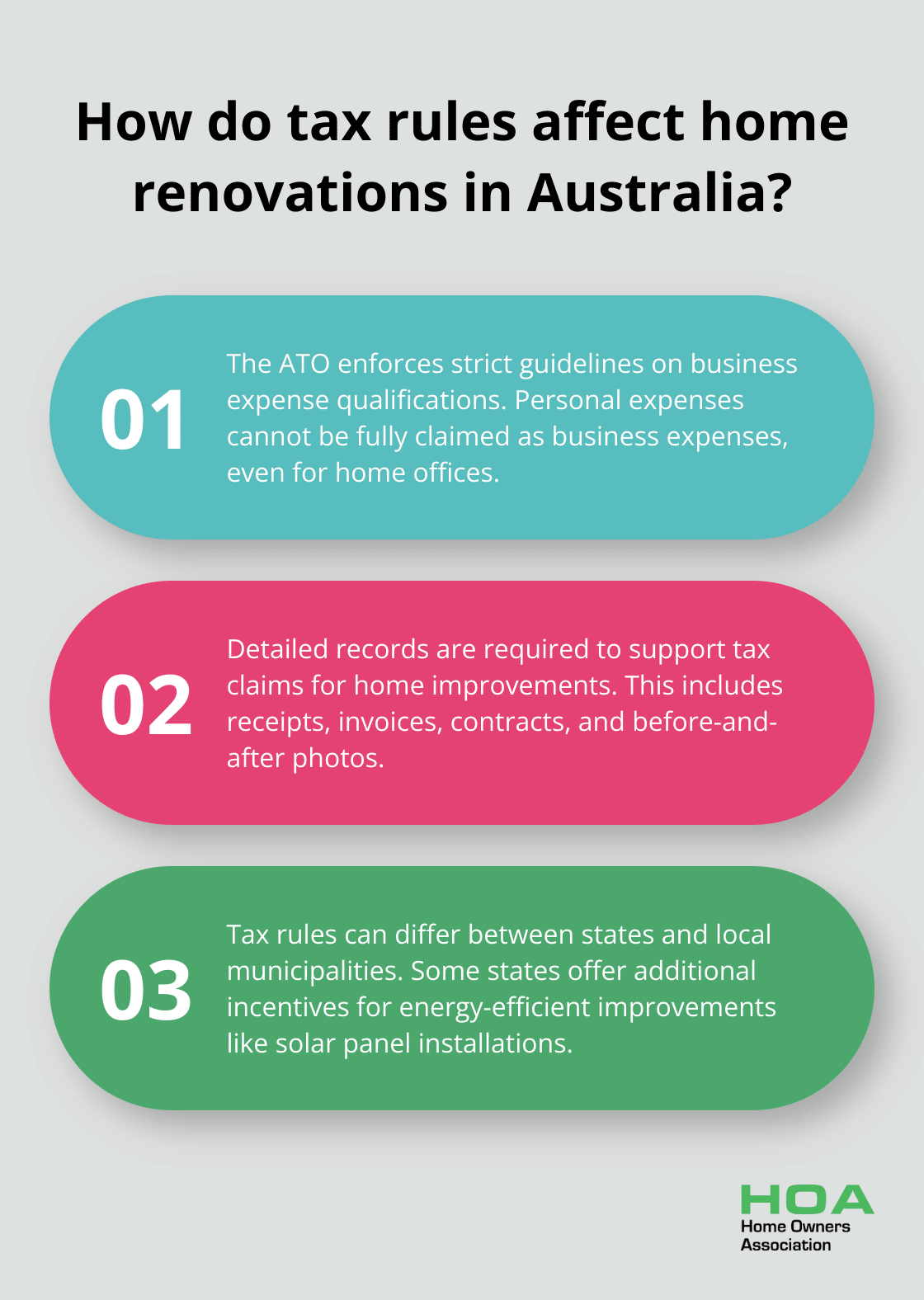
To prevent this error, establish a clear division between personal and business areas in your home. If you’re uncertain about expense classification, seek advice from a tax professional who can guide you on proper cost allocation between personal and business use.
Maintaining Meticulous Records
Inadequate documentation of renovation expenses is a common mistake. The ATO requires detailed records to support tax claims related to home improvements. This includes receipts, invoices, contracts, and before-and-after photos of renovated areas.
Start a dedicated file for all renovation-related documents at the beginning of your project planning. Digital record-keeping tools can help organize and store this information effectively. As the taxpayer, you bear the burden of proof, so comprehensive documentation serves as your best defense in case of an audit.
Navigating Local and State Tax Rules
Many homeowners overlook the fact that tax rules can differ significantly between states and even local municipalities. While federal tax credits for energy-efficient improvements remain consistent across Australia, state and local governments may offer additional incentives or have specific requirements for claiming these benefits.
Investigate your local and state tax laws before initiating any renovation project. Some states provide extra rebates for solar panel installations or energy-efficient appliances. Others might have particular requirements for claiming home office deductions. Staying informed about these local nuances can result in substantial additional savings.
Avoiding Overclaiming
Homeowners sometimes attempt to claim tax benefits for improvements that don’t qualify. The ATO specifies that only certain types of renovations are eligible for tax deductions or credits. For instance, cosmetic upgrades like painting or new carpeting typically don’t qualify for tax benefits, while energy-efficient improvements often do.
Try to understand the specific criteria for each type of tax benefit before claiming it on your return. Consult the ATO’s guidelines or speak with a tax professional to ensure you’re only claiming eligible expenses.
Timing Your Renovations Strategically
The timing of your renovations can impact your tax benefits. Some tax credits have annual limits, while others might be more advantageous if spread over multiple tax years.
Plan your renovations strategically to maximize these annual limits. Consider spreading large projects across tax years if it allows you to claim more in total tax benefits. This approach requires careful planning and record-keeping, but it can significantly increase your overall tax savings.
Final Thoughts
The new tax rules for home renovations in 2024 bring significant changes and opportunities for homeowners. These updates focus on energy-efficient improvements, introduce stricter eligibility criteria, and emphasize proper documentation. Homeowners who understand these changes can make informed decisions about their renovation projects and maximize their tax benefits.
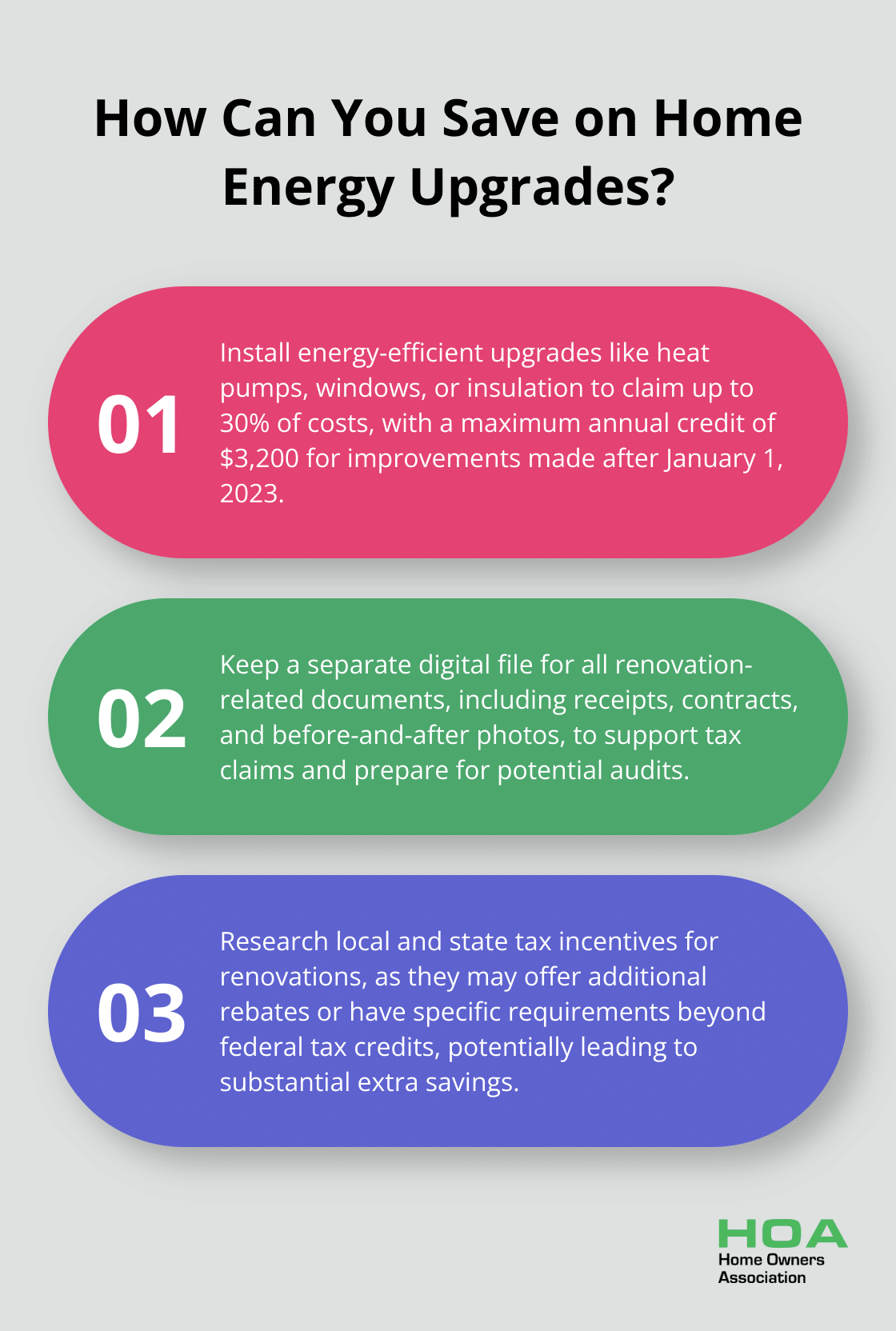
Tax regulations for home improvements are complex and ever-changing. Homeowners should consult with tax professionals who can provide personalized advice based on specific situations. These experts can help navigate the intricacies of the new tax rules, ensure compliance, and optimize tax strategies.
We at Home Owners Association support our members through these changes. Our team offers expert advice on renovation planning, connects members with trusted professionals, and provides access to trade pricing and discounts on construction materials (subject to availability). Homeowners can confidently undertake renovation projects that improve their living spaces and maximize their tax benefits.





